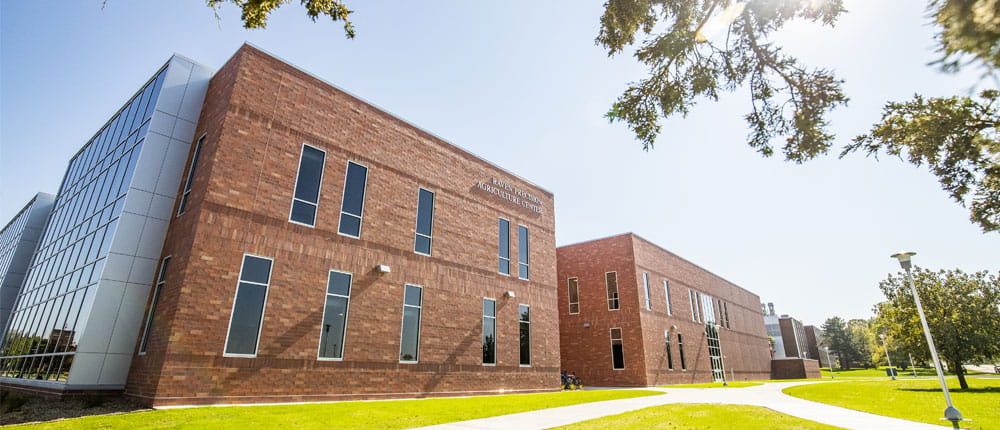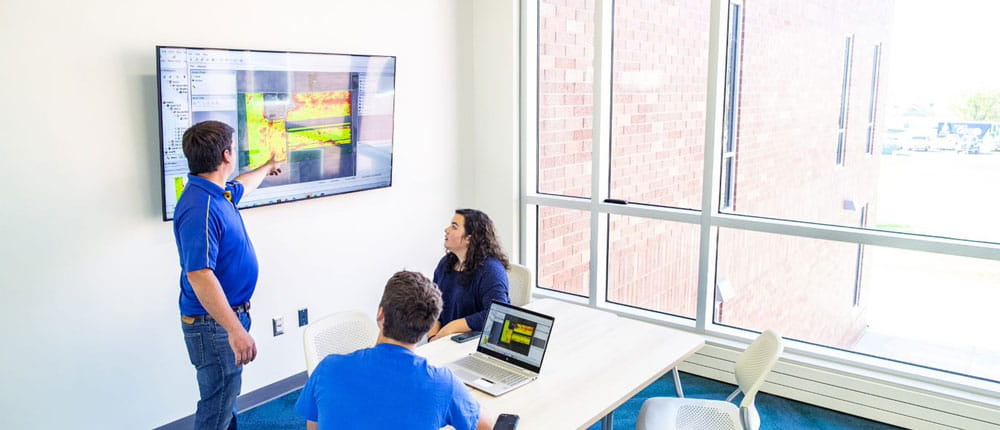On a sunny Saturday in September 2021, a large group of people gathered outside an impressive new 122,694-square-foot building of brick and glass on the Brookings, S.D., campus of South Dakota State University (SDSU). They were there to celebrate the grand opening of the new Raven Precision Agriculture Center. The event was significant for several reasons.
The $46.1 million facility represented a major investment made by the state and agricultural companies in the next generation of agricultural education, with a primary focus on precision technologies.
The new facility is home to a new type of ag major, the country’s first four-year degree in precision agriculture and features state-of-the-art classrooms, labs and spaces for industry collaboration.

Meeting a need in agriculture education
The journey began when SDSU started to expand its ag systems technology major in 2009, recalls Nic Uilk, precision ag instructor. “We saw the need everywhere for more focused coursework on precision ag philosophy and tools. Equipment dealers, cooperative managers and ag bankers all said they wanted ag graduates with a better understanding of the field. We also had students asking for it.”
He attributes the university’s rapid progress in developing the program to Barry Dunn, then dean of the College of Agriculture and Biological Sciences and now SDSU president. “He recognized the industry need and was a major driving force in fundraising and in supporting curricular development,” says Uilk.
By 2015, the college had introduced a minor in precision agriculture and, in 2016, SDSU became the first land grant university in the U.S. to offer students a degree in precision ag. By May 2021, the program had 36 graduates. Today, 82 students are enrolled in the major and 57 have declared precision ag as a minor.
It wasn’t just Upper Midwest students attracted to the new program, notes Uilk. “In the first year it was offered, we drew students from Wisconsin, Illinois, Ohio, Texas and Washington.”
Opportunities in agriculture careers
SDSU senior Parker Aase is one of those precision ag majors who has long known he wanted an active, ag-based career. “I definitely don’t want to spend the bulk of my workdays sitting in an office.”
The Owatonna, Minn., native didn’t grow up on a farm, but has roots in rural communities, showed livestock in 4-H and took ag classes in high school.
“I wanted to major in agronomy, but after I had taken a few precision ag classes here at SDSU, I felt it was a great way to apply all the agronomy basics I was learning, so decided to double-major.
“I really like the data-mapping classes because they’ve helped me understand how to make all that information useful to farmers,” he says. “I have already been able to help farming friends of mine create field input maps that help them control costs.”
The program’s hands-on approach extends beyond the classroom, with faculty members helping students find summer internships. “Our faculty maintain close connections with local agribusiness people, both personally and through our industry advisory board,” says Uilk. “We hold annual career fairs and other events that allow our students to meet people working in the industries they’re interested in. Those connections are really valuable. That’s how many find summer internships.”
During his freshman year, Aase met an executive at Raven at a college event, which led to his first summer internship with the company working in customer service and training. The following summer, he interned with a seed company and last summer he was back at Raven, learning more about technical development of the company’s autonomous grain carts and the Omnipower self-propelled power platform.
“I’ve really enjoyed all of my internships and learned so much,” says Aase, adding he’d be happy doing any of those jobs full-time after graduation.
Investing in precision ag education
Creating and refining high school and college programs takes resources. The CHS Foundation has committed more than $2.3 million since 2018 to support new and expanding precision agriculture programs at colleges and universities around the country. Some include:
$1.5 million to support the South Dakota State University precision agriculture program and construction of the new Raven Precision Agriculture Center on the university’s Brookings campus
- $272,676 to the University of Idaho to develop a precision ag certificate program
- $196,697 to the University of Illinois to implement a new computer science and crop science major
- $120,000 to West Texas A&M University to create curriculum in seven urban high schools that targets more diverse students from nonag backgrounds
- $80,000 to the University of Nebraska-Lincoln for a diversity student mentor program
- $70,000 to Bismarck State College for a precision agriculture active learning classroom
“The CHS Foundation is committed to supporting projects that cultivate opportunities for students interested in agriculture and help to produce qualified graduates to fill the needs of the industry,” says Nanci Lilja, president, CHS Foundation. “The ag industry needs to be innovative in how it attracts talent. These institutions are delivering on those innovations and using unique approaches to reach the next generation of ag leaders.”
What makes precision ag education different
Along with loving technology and hands-on learning, SDSU junior Rosalyn Madsen wants a job where she can work with people. “I’d love to work as a tech specialist, installing precision ag technology and helping customers solve problems. Maybe someday I will even run my own business.”
Taking her first introductory precision ag course, which allows students to work on a fleet of Kubota tractors fitted with autosteer systems, solidified Madsen’s decision in the major. “The work combines my love of agronomy with the chance to work with my hands. This technology is definitely where everything is headed, which makes it exciting.”
Madsen’s family lives outside Franklin, Minn., but doesn’t farm. Most of her ag experience has come by taking high school classes, participating in FFA and helping on a neighbor’s farm. Last summer, she interned at Central Region Cooperative, based in Fairfax, Minn., loading out crop protection products, consulting on applications and scouting crops. “I got customer interaction experience and great practice identifying weeds and pests.”
Summer internships are important for providing practical experience because the SDSU precision ag major requires 120 credits, with very little room for electives. “We need to provide a solid foundation in agronomy, along with electrical and equipment courses. That’s a lot to fit into four years,” says Uilk.
Most upper-level courses have labs, as well, which meet at least two hours per week. “While most of the classes went online during the 2020–2021 school year because of the pandemic, labs were able to continue in person, operated with recommended precautions,” he says. “This year, we’re back to mostly in-person classes.”
SDSU currently has an articulation agreement with Mitchell Technical Institute in Mitchell, S.D., that allows students from that two-year school’s precision ag technology program to transfer credits into the SDSU four-year program. “We’re talking with a few other two-year institutions to set up a similar agreement,” says Uilk. “There is definitely a lot of demand.”
He says about half of the program’s graduates have gotten jobs in agronomy and half are working with ag equipment.
“A few have gone home to farm, but most have their pick of jobs when they graduate.”
Turning precision ag education into a career
That was the case for Tonner Bowman, Garretson, S.D., who has been working in agronomy sales for the CHS location based in Brandon, S.D., since he graduated from SDSU with a precision ag degree in May 2019. “I had multiple job offers, but decided to return to my home community,” he says.
Bowman interned at the cooperative the summer before he left for college and at another one of its locations for two summers while at SDSU.
“I initially majored in agronomy, but felt like everything we talked about in other classes came together when I took precision ag-mapping classes. Learning how to work with the data and make recommendations and having the chance to go more in-depth on the equipment side of it was important.”
Bowman says he uses most of those skills every day in his work with growers in eastern South Dakota and western Minnesota. “I’m largely focused on soil fertility, using grid soil sampling, interpreting those results to write fertilizer recommendations and develop variable-rate application maps, plus interpreting harvest results.
“We now have the Agellum® farm management and planning tool to help us harness the power of all that data and help growers make management decisions that help maximize returns,” he says. “It takes so much of the guesswork out of crop management.”
Bowman recently took a sales agronomist position with the cooperative and finding a precision ag specialist to replace him hasn’t been easy, says Bob Goodroad, agronomist and seed manager for CHS at Brandon. Goodroad also coordinates internships for the business. “Right now, there simply aren’t enough qualified candidates to go around.”
Staffing needs are one reason why the CHS staff at Brandon has supported the new SDSU program and why the team stays in regular contact with Uilk and other precision ag faculty.
At least once a year, they get together to discuss what they see happening in the industry and topics that should be covered in the classroom. And the co-op is providing hands-on training by hosting 12 to 20 interns each summer. It even works to customize internships to fit individual students’ careers goals and experience gaps, says Goodroad. Each year, two or three former interns are hired by the co-op for permanent positions after they graduate.
“We’re training students, but we’re also trying to build our bench. It’s a chance for us to sell the students on the benefits of working for us and show them the potential for growth and career advancement in the cooperative system.”
As an SDSU alum, Uilk says one of the best things about the school’s newest program is that it creates opportunities for rural students to develop the skills needed to go back and work in their home communities. “There is no shortage of opportunities in agriculture. Students just need to get the right skills and experience.”
Check out the full C magazine with this article and more.




